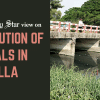Save Shibsa River from further decline

We are concerned about the growing trend of rivers drying up in Bangladesh. The plight of the Shibsa River, as highlighted by a recent report, is yet another example of how careless our treatment of rivers has been. Once a vital communication route linking Khulna to Kolkata, the Shibsa used to bustle with boats, launches, steamers, and so on. Today, however, it has declined drastically, reduced to a narrow stream in many parts. This dried-up condition spans roughly 27 kilometres of the river as it flows through the Paikgachha upazila. From there, it continues eastward through Soladana and Garuikhali unions before entering the Sundarbans and merging with the Pasur River. Although its 64-kilometre portion inside the Sundarbans still carries tidal water, heavy siltation is rapidly reducing its depth.
This situation cannot be attributed to any one reason alone; rather, it is the result of decades of unplanned, often illegal interventions such as the construction of polders and embankments as well as encroachment on riverbanks. For instance, around a hundred ponds and various structures have been set up along the Shibsa's banks, leading to persistent waterlogging in surrounding areas. Over the years, many rivers have been similarly choked by encroachment, pollution, and short-sighted government projects cutting floodplains off from them, increasing siltation, and eventually making rivers shallower.
Following the fall of the Awami League government, there have been noticeable efforts against illegal settlements along riverbanks, but those have proved to be insufficient in addressing the decline of our rivers. The fact is, without comprehensive measures addressing all the interlinked issues, our rivers cannot be saved. One major concern in this regard is the persistent inactivity of the National River Conservation Commission (NRCC), the so-called guardian of rivers. The delay in reactivating this commission—currently run by an additional secretary who merely holds its chairman's responsibilities on an additional basis—has compromised its ability to steer river conservation efforts.
These issues need to be resolved. Saving rivers like the Shibsa requires a holistic strategy based on sound river management principles. This includes reactivating and strengthening oversight institutions like the NRCC, implementing the Tidal River Management (TRM) system to restore natural tidal flows, preventing illegal occupation of riverbanks by local administrations, and conducting regular dredging. At the same time, there must be greater public awareness of their pivotal role in river conservation. We must also hold relevant authorities accountable for negligence and wrong policies.


 For all latest news, follow The Daily Star's Google News channel.
For all latest news, follow The Daily Star's Google News channel. 










Comments